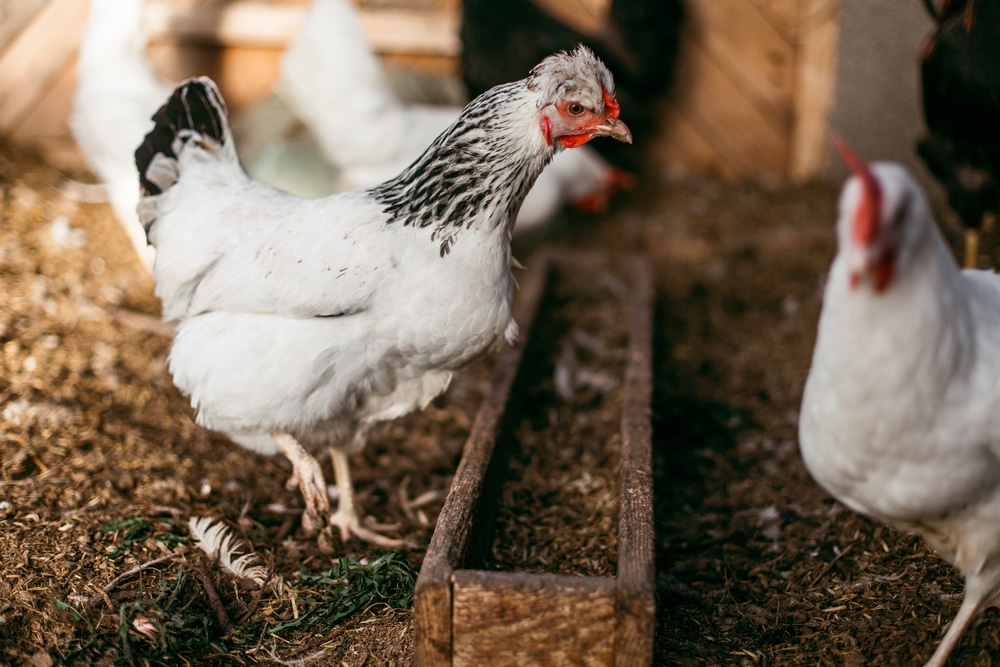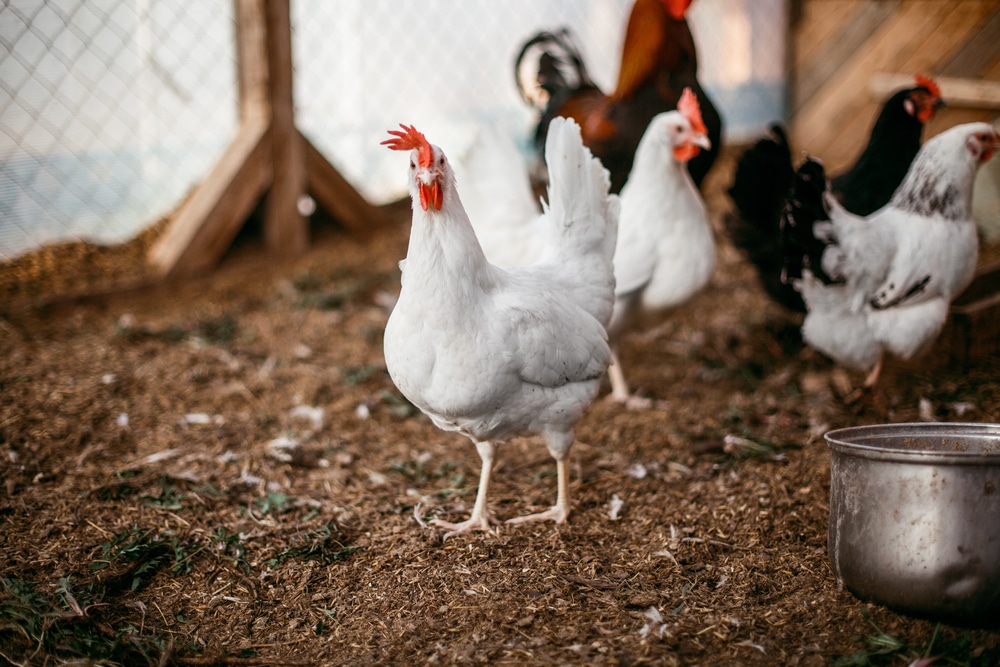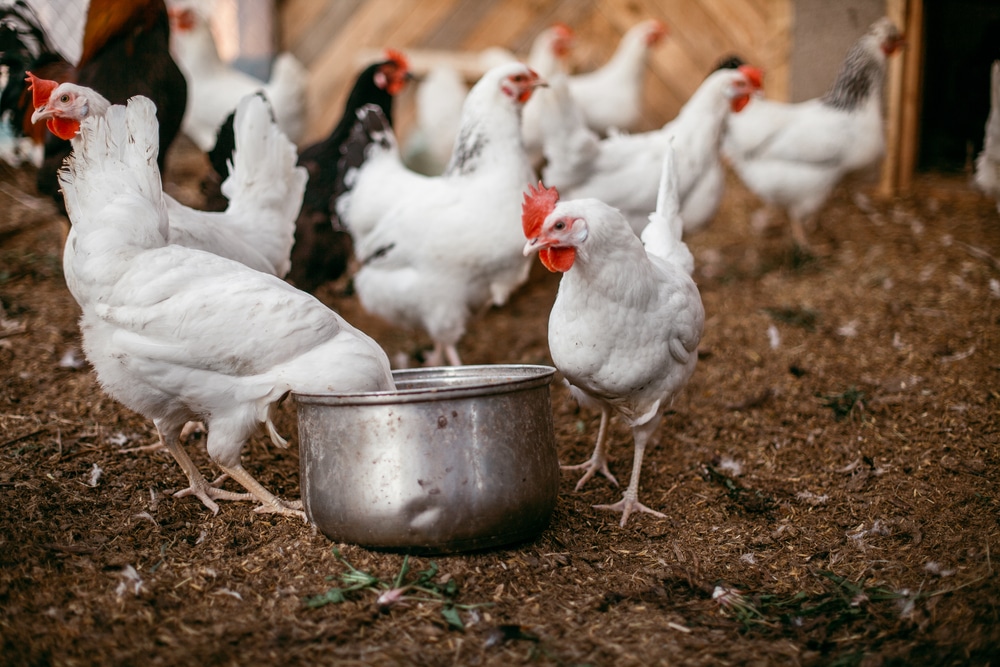Imagine this – you only clean the chicken coop once, maybe twice, a year.
“No,” you might be thinking, “That can’t be safe, or sanitary, or a good idea in any way!”
With the deep litter method of bedding chickens, that concept is not only a reality, but it’s beneficial.
You read that right – you can improve the health of your chickens while only having to clean the coop on an annual or semi-annual basis.
So what is the deep litter method for chickens, and more importantly, can it work for you? In this guide, we will tell you everything you need to know.
What is the Deep Litter Method for Chickens?
The deep litter method for chickens involves allowing chicken waste and bedding material to decompose on the floor of the chicken coop instead of being scraped out and replaced on a weekly basis.

When you use the deep litter method, you will use carbon-based bedding like pine shavings, paper, or straw. This material will absorb the nitrogen from the chicken droppings, and the two will work together to create nutrient-rich, odor-free humus that can then be used in your garden. In fact, it will be just as beneficial as compost!
There are plenty of benefits to using the deep litter method for chickens. Not only can it be a serious time-saver, but it can be a healthy waste management system when done correctly.
Is It the Same as Composting?
The deep litter method for chickens is often viewed in the same light as composting. Although they are very similar, there are a couple of differences.
In general, though, they operate under the same principles. Composting moves through three distinct phases. The first is a moderate-temperature phase, which lasts a few days or several months, depending on the conditions, before it then moves into cooling and maturation phases.
These phases are influenced and triggered by various microorganisms, including bacteria and fungi, along with macroorganisms like beetles and flies. For organic matter to be effectively turned into usable compost, it must be fed, watered, and oxygenated properly.
If you are managing a typical compost pile, you will do this yourself, allowing rain to water the compost and turning your compost with a pitchfork every so often. In a deep litter system, the chickens do the turning for you.
What Are the Requirements for a Deep Litter System?
For a deep litter method for chickens to be successful, you are going to need to incorporate a few different factors.
First, you will need a litter material that is carbon-based and ample in quantity. This can be grass clippings, leaves, pine shavings, shredded paper, or another bedding type of choice. You won’t want to use something like sand for the deep litter system, although this works well in other bedding set-ups.
You will also need chicken droppings. If you have chickens, that shouldn’t be a problem! As you likely know, chicken waste is rich in nitrogen and is the perfect complement to your carbon-based bedding source.
You will also need to properly aerate the system. Your chickens will do most of this for you, turning it as they go about their daily business, looking for bugs and microorganisms. However, on occasion, you may need to turn sections of the litter that have been overlooked by your birds.
For a deep litter system to be effective, it needs the utmost attention of your birds. If your chickens stay outside most of the day and only return to the coop at night, you may find that your litter does not get turned as often as is ideal. Therefore, you may want to consider deep litter only if your flock is indoors much of the time (such as during the winter).
Your coop also needs to be well-ventilated. If you can, invest some time in making sure your coop has open eaves and good cross-ventilation. There should be no heavy drafts, though, especially in this space above the roosts. Ventilation is important because it will give the built-up moisture and ammonia a place to escape.
When it comes to moisture, this factor cannot be overlooked. However, too much moisture is just as bad as too little. Wet bedding can make your chickens sick. Since chicken droppings are more than 80% water, you won’t need to add any extra moisture to your litter – the chickens will take care of that for you.
However, you will need to keep an eye out for leaks and spills so that the bedding doesn’t become overly sodden.
Helpful Tips for a Successful System

There are some easy tips you can follow to make sure your chickens thrive in a deep litter system.
Start in the Spring
Even if you only plan on housing your chickens in a deep litter system during the winter, winter is not the ideal time to start building up the litter. As with a compost pile, litter requires a lot of heat to start decomposing. Therefore, it should be entering its warmest phase of decomposition in the fall. This will help add additional heat to your coop during the times it is most needed.
Begin with Dry Bedding
Begin your deep litter system with at least six inches of a dry bedding type, like pine shavings. You will want to avoid materials with a higher moisture content, like grass or straw.
These materials also tend to be too large to break down quickly. Pine shavings, on the other hand, are quite fine in texture and so will break down fast. These will help jumpstart the process of decomposition.
You should avoid using hay or straw for the initial litter. They can both harbor mold, which not only will slow down your decomposition but can also be damaging to the lungs of your chickens. They also aren’t as absorbent as some of the other materials. Instead, let the wood shavings work together with the manure to build a healthy population of microorganisms (and heat) before you add alternative bedding material.
Manage Your Flock Size
Try not to overcrowd your coop. This is a good rule of thumb regardless of what bedding style you use, but it’s especially important for deep litter.
If you have too many chickens, you’re going to have too much poop (and that’s never a good thing). If you have too much poop in a deep litter system, your ratios of carbon to nitrogen are going to be imbalanced and the deep litter method will fail.
Remember to maintain a ratio of four square feet per bird inside the coop – more if you can afford it!
Keep it Deep
It can be tempting to keep scraping away at the top layer of your deep litter system, but try your best to avoid this. Keep the litter at least four to six inches deep. As the pile decomposes, add more litter. You can also add litter whenever things start to get stinky or unappealing.
Because of this height and build-up, you may need to adjust the doorway or other entrances to your coop. Sometimes, doors won’t shut properly once the litter starts to accumulate.
Once the litter reaches a foot or so in height, it’s time to start removing it, bit by bit. Take a few inches off the top until you’re back to the four- to six-inch height. This will make the pile more manageable for your chickens and the microbes. Go ahead and use the litter in your garden!
When it’s time for some spring cleaning at the end of winter, don’t feel like you have to take everything out. Actually, you should avoid doing this. Leave a few inches on the bottom of the coop floor. It will help jumpstart the next batch as all of the microbes will already be in place.
Remember to Aerate and Monitor for Moisture
While your chickens will do most of the turning for you, inspect your coop floor on a regular basis to make sure the entire litter system is aerated. You will want to make sure your chickens haven’t missed any spots.
If any sections of the litter begin to look white or ashen, they are oxygen-deprived. Make sure you break these up and turn them as soon as possible.
You will also need to keep a close eye on the moisture content of your bedding. It should be equally moist and consistent without any lumps or super sodden spots mixed in. if you pick up the litter and squeeze it, it should not release any water. It should hold its shape and then crumble. Turning your litter can help distribute moisture evenly around the coop.
Avoid Diatomaceous Earth
Don’t use diatomaceous earth in a deep litter system, even if you’re trying to control for parasites like mites and lice. You can use it outdoors in a dust bath or run instead.
The reason for this is that diatomaceous earth is naturally drying. It will dry out the litter in your coop and can kill off the beneficial microorganisms you are trying so hard to promote. It also has insecticidal properties.
Keep it Stink-Free
Prevent ammonia smells from building up inside the coop. This is a sure sign that your deep litter method is failing. Not only can it damage the lungs and eyes of your chickens, but it can also make them more vulnerable to disease. Even their laying can shut off.
To prevent ammonia odors, make sure you have good ventilation and adequate moisture levels. Prevent the bedding from staying wet, as this will not only promote ammonia build-up but can also harbor mold, bacteria, coccidiosis, and even lead to bumblefoot.
Quit Cleaning…Kind Of
Stop being a neat freak! You don’t need to remove deep litter on a regular basis. Instead, you should remove litter only when it is fully composted and has reached a foot or more in height. If you remove litter too soon, it will never have the opportunity to get to the high heat composting phase.
Watch Out For Disease
If you have any outbreak of disease in your flock – of any kind, be it parasites or a bacterial or viral illness – make sure you remove all of the deep litter. It’s time to clean it out, sanitize your coop, and start all over. Yes, this can be frustrating – however, it’s essential to prevent disease from spreading among your flock.
Pros and Cons of the Deep Litter Method
Here are a few benefits and drawbacks of a deep litter system:
Benefits
There are plenty of advantages to using a deep litter system. Not only is it maintenance -free (well, mostly maintenance free) but it also works year-round.
It works well in wet climates as long as you monitor moisture levels. It also works well in more arid conditions. It is ideal in the winter, when it releases heat into the coop and helps make it a more welcoming environment for your chickens. As the litter breaks down, it naturally releases heat and keeps the birds warm.
Because deep litter introduces beneficial microbes to the coop, it helps keep harmful microbes at bay. There are also studies that suggest that chickens raised on deep litter have more access to vitamin B-12, helping them grow larger and healthier than those raised on other types of bedding. It also has anticoccidial properties.
Deep litter can reduce odor and nutrient loading, too. After all, depositing too much nitrogen (found, of course, in chicken droppings) in one area can be bad for the land. This reduces manure run-off and is a safer way to manage chicken manure, especially if you have lots of chickens.
You’ll only need to clean the coop once or twice per year. It can be used in any size coop with any size flock. It gives them something to do when they are locked up inside the coop. No more cabin fever, and a happy flock of chickens – sounds like a win-win.
The deep litter method for chickens can also be more economical for you. Since you aren’t removing and replacing all of the bedding each week, you can add smaller amounts of new litter to the coop – this means less expense when it comes to buying shavings or straw.
Oh – and let’s not forget all the free compost you’ll get for your garden!
Drawbacks
Although a deep litter bedding system is advantageous in many ways, there are a few disadvantages to this method that you need to be aware of, too.
For starters, deep litter does not work as well for a small flock of mixed-age birds. Some of your younger birds might have a harder time scratching around in the litter and can easily become stuck in all the bedding.
A small flock may also not be able to handle the workload of turning a deep litter bedding on a regular basis, meaning the bedding will pile up and become stinky before it ever starts to break down to a useful point.
Also, deep litter systems should only be built on dirt floors. Wood floors can absorb moisture and ammonia, hastening the time it takes for them to rot. Similarly, concrete does not allow for proper drainage, nor does it encourage the growth of microbes.
And if you do have a dirt floor, you’ll have several other concerns to worry about despite the fact that deep litter works well. It will be easier for predators to get inside and it may be more difficult for you to shut your doors once bedding begins to pack together.
Deep litter should only be used with chickens and not with other types of poultry, in particular, ducks. Ducks like to splash around a lot in the water, which can cause the litter to become too wet and harbor mold and fungus.
Finally, a deep litter system needs to stay damp beneath the top layer. As a result, there can be lots of moisture in the air. This means you’ll need a well-ventilated coop to prevent issues like frostbite and respiratory disease.
Does a Deep Litter System of Bedding Encourage Parasites?
There are some people who argue that the deep litter method of bedding can encourage parasites.
There is some truth to this. If deep litter is not done correctly, it can harbor Capillaria worms, bacteria, and of course, ammonia gases. These can all be harmful to a chicken’s health.
That being said, when managed properly, the deep litter system can actually decrease parasite and pest loads. The beneficial microbes harbored in the deepest layers of the bedding system often eat mosquito and fly larvae before they ever develop.
Why the Deep Litter Method is Often the Way to Go
Despite all of the potential struggles associated with a deep litter method of bedding, there are plenty of advantages to bedding your chickens in this fashion, too. Not only will your birds have access to all kinds of beneficial microbes, but you’ll be able to significantly reduce your workload when it comes to keeping the coop clean, too.
Many of the struggles you might encounter with the deep litter method can be easily mitigated with a bit of good management. Consider giving it a try with your chickens this year for less work, less stress, and most importantly – free compost!
